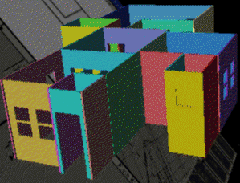CASA: Computer Augmentation for Smart Architectonics
August 1st, 1994 - May 1st, 1995
Categories: Applications, Architecture, Human Factors, MS / PhD Thesis, Tele-Immersion

About
Homes or buildings that utilize technology in order to be “smart,” computer augmented, automated, “intuitive,” energy efficient, or just convenient, have been in existence since the mid-1980s. The technology used has ranged from simple timers that control household appliances at designated times during the day, to computer control of office environments.
In the latter, the goal has been to hide the computers in the environment while providing support for humans in their everyday activities. There are already many instances where humans have used computers in this manner. These computers have been hidden inside everyday appliances and equipment like automobiles and VCRs. However, it is interesting to observe that the most difficult to use appliances are typically those that have the most computer-like interface (e.g., VCRs and microwave ovens), whereas the ones easiest to use are those that hide the computer interface (e.g., cars and refrigerators). Beyond the management of “creature comforts” for homes, “smart” environments can be invaluable aids in the work environment.
One environment we have been considering is the computer augmentation of the beamline control system at Argonne’s Advanced Photon Source. The beamline is a resource for scientists who conduct xray crystallogrphy. The operation of the beamline hardware and software requires a complex series of specific steps that result in the gathering and analysis of gigabytes of data. Since the beamline is a time-shared facility, users operate under strict time constraints that require them to work 24 hours a day for a period of about four days. These stringent conditions, in the least, lead to user fatigue. However, fatigue can lead to user error in the handling of hardware that can result in costly damage of equipment. For example, forgetting to place a beam stop before firing the beamline can destroy a $100,000 detector. In addition, mistakes caused by fatigue can induce errors in data collection, which may eventually corrupt entire experimental results. It is these types of errors which we propose could be avoided through the implementation of computer-augmented environments.
We believe the CAVE is a fascinating possibility for use as a prototyping tool for these types of environments. As we all know, architectural walkthroughs are considered the “killer application” for virtual reality, and the CAVE is one of the better ones for this. We decided it would be interesting to take the next step in architectural walkthroughs, and put some intelligence inside the architectural models - in essence providing a virtual-reality testbed for designing and debugging “smart” environments.
The first prototype of CASA was displayed recently at EVE4 (Electronic Visualization Event 4) in Chicago. The prototype featured a tour through a virtual “smart” home, depicting a house of the future. The prototype served as a means to experiment with a number of enabling technologies, one of which included CAVE-to-CAVE collaboration.